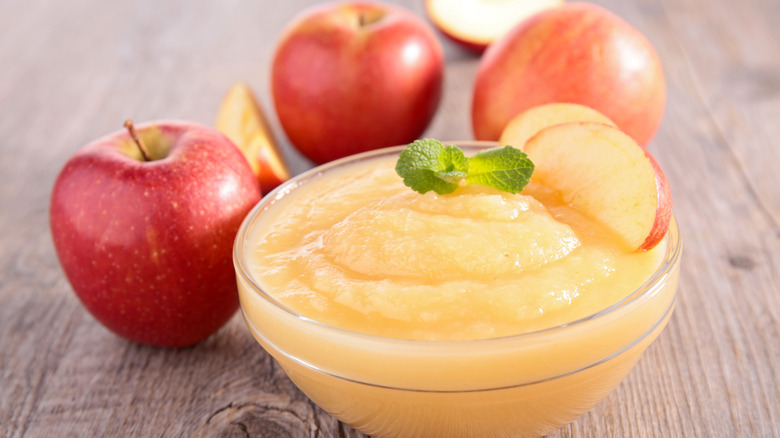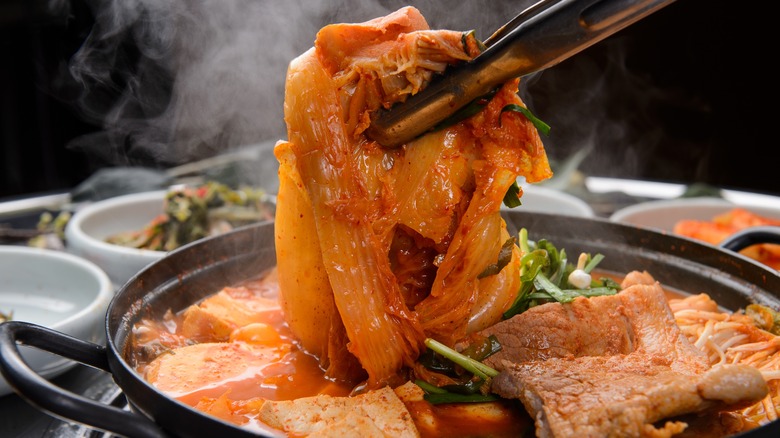Applesauce Is The Ingredient You Need To Make Your Kimchi Stand Out
Kimchi is a staple of Korean cuisine, offering both flavor and nutrition. Its distinct aroma comes from a mix of traditional seasonings and fermented vegetables, such as napa cabbage, Korean radish, ginger, and red pepper powder, or gochugaru. However, there are over 200 varieties of kimchi — and each requires slightly different components. Some are made with unexpected ingredients like mustard leaves, perilla leaves, squid, and oysters.
But have you ever considered using applesauce in kimchi? With their naturally sweet flavor, apples can balance the saltiness and sourness of the dish while increasing its nutritional value. That's right — unsweetened applesauce is chock-full of vitamin A, vitamin C, calcium, potassium, magnesium, fiber, and antioxidants and has just 103 calories per cup. Plus, it pairs well with ginger, cucumbers, carrots, Asian pears, and other ingredients used in kimchi recipes. The resulting flavor will be subtle and smooth, making it particularly enjoyable for those who prefer a milder version of kimchi.
Applesauce might be the secret to better-tasting kimchi
Applesauce is one of the best egg substitutes for baking, but it also works well in savory dishes like bibimbap, pork roast, or barbecue chicken. This delicious ingredient can also help reduce the heat and acidity of kimchi, creating a more rounded flavor profile. Its fruity sweetness blends seamlessly with the nuanced heat of gochugaru, sriracha, or ginger while preserving the umami of the dish.
Need another reason to incorporate applesauce into kimchi? This food product is rich in natural sugars (up to 23 grams per cup) that can speed up fermentation. Therefore, you can use it as a substitute for table sugar or Asian pears, which serve the same purpose.
Ideally, opt for unsweetened (and unspiced) applesauce because the extra sugar and spices in those varieties may overpower the other ingredients. Add a small amount to the kimchi paste, taste it, and then adjust it as needed to achieve the desired sweetness. Alternatively, use apple puree, which tastes the same as applesauce but has a smoother consistency.
Get creative with the other ingredients
Ask five different chefs how they make kimchi, and you'll get five different answers. The thing is, this traditional Korean dish leaves a lot of room for creativity and can be customized to suit your taste. For example, culinary science expert Majestic Lewis-Bryant uses Napa cabbage, anchovy fish sauce, gochugaru, and salted fermented shrimp.
Chef Yong Soo Do, on the other hand, swears by choi sum, or Chinese flowering cabbage. His go-to kimchi recipe is much different than that of Lewis-Bryant. "It's very farm-to-table food. Basically, whatever you can get in your region, you can put in it. That's why kimchi is so interesting; even if you go to a different city, the style of the kimchi changes and the flavor changes," he told the South China Morning Post.
Depending on the recipe, the dish may also contain broccoli, eggplant, leeks, pine nuts, and other surprising ingredients. For instance, David Chang's secret ingredient for deliciously quick kimchi is 7Up. The award-winning chef says this beverage adds sweetness and acidity, resulting in a more balanced flavor. To that end, there's nothing wrong with substituting ingredients. If, say, you run out of rice flour, you can use tapioca flour, cornstarch, or potato starch. Similarly, if you're out of the jarred stuff and only have whole apples on hand, you can easily whip up a batch of raw applesauce in the blender.


